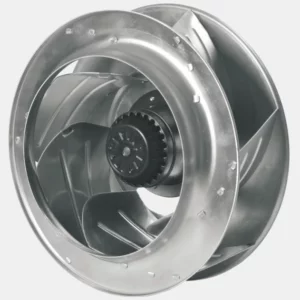An AC backward curved centrifugal fan, also known as a backward curved impeller fan, is a type of centrifugal fan that is designed with curved blades that curve away from the direction of rotation. This specific blade design allows for efficient airflow and pressure generation.
Here’s how an AC backward curved centrifugal fan typically works:
- Air Intake: The fan draws in air through its inlet or intake. The inlet is typically located in the center of the fan housing.
- Impeller and Motor: The impeller is a rotating component of the fan that consists of curved blades arranged in a radial pattern. It is connected to an AC motor that provides the rotational power.
- Air Acceleration: As the impeller rotates, the curved blades accelerate the incoming air radially outward due to centrifugal force. The curved shape of the blades helps in smoothly and efficiently accelerating the air.
- Pressure Generation: The accelerated air creates a pressure difference, resulting in an increase in air pressure. The backward curved blades are specifically designed to generate higher pressure compared to other blade configurations, making them suitable for applications requiring high-pressure airflow.
- Air Discharge: The high-pressure air is discharged from the impeller into the fan housing or ductwork connected to the fan outlet. The fan housing may have additional components such as diffusers or volutes to direct and optimize the airflow.
- Cooling: Depending on the application, the AC motor may be exposed to the airflow generated by the centrifugal fan. The airflow helps in cooling the motor, preventing overheating.
AC backward curved centrifugal fans are known for their energy efficiency and relatively low noise levels compared to other fan types. Their backward curved blades are designed to handle high volumes of air and generate significant static pressure, making them suitable for various HVAC (heating, ventilation, and air conditioning) applications, air handling units, cooling systems, and other industrial and commercial ventilation needs.
It’s important to note that specific fan designs and configurations can vary among manufacturers, and additional features such as speed control, ac backward curved centrifugal fan housing design, and motor type can further enhance the performance and efficiency of the AC backward curved centrifugal fan.
What is the role of ac backward curved centrifugal fan?
The AC backward curved centrifugal fan plays a crucial role in various applications that require efficient airflow and pressure generation. Its specific design and characteristics make it suitable for a range of purposes. Here are some common roles and applications of AC backward curved centrifugal fans:
- Ventilation and Air Circulation: AC backward curved centrifugal fans are widely used for general ventilation purposes. They help circulate and distribute air within buildings, ensuring fresh air supply and removing stagnant or polluted air. They can be found in HVAC systems, commercial buildings, offices, shopping malls, and other indoor spaces.
- Air Conditioning Systems: In air conditioning systems, AC backward curved centrifugal fans assist in the supply and distribution of conditioned air. They work in conjunction with cooling coils or heat exchangers to deliver cool or warm air to different areas within a building. These fans are commonly used in air handling units (AHUs) and rooftop units (RTUs) found in commercial and residential HVAC systems.
- Heat Dissipation: AC backward curved centrifugal fans are used for heat dissipation in various applications. They help to remove heat generated by electronic components, machinery, or industrial processes. These fans are often found in computer servers, electronic cabinets, control panels, and industrial equipment where cooling is crucial to prevent overheating and ensure proper functioning.
- Industrial Ventilation: In industrial settings, AC backward curved centrifugal fans are employed for ventilation and exhaust purposes. They help remove fumes, smoke, dust, and other airborne particles from the working environment, improving air quality and maintaining a safe and healthy workplace. Industries such as manufacturing, welding, chemical processing, and woodworking often rely on these fans for effective ventilation.
- Cooling Towers: AC backward curved centrifugal fans are used in cooling towers, which are crucial components of industrial cooling systems. These fans help to draw air through the tower, facilitating the cooling process by removing heat from water or other cooling media. The high-pressure airflow generated by these fans enhances the cooling efficiency of the tower.
- Energy Recovery Systems: AC backward curved centrifugal fans are sometimes incorporated into energy recovery systems. These systems capture and utilize waste heat or energy from exhaust air streams to preheat or precool incoming fresh air. The fans help in the exchange of heat between the exhaust and supply air streams, contributing to energy efficiency and cost savings.
The role and application of AC backward curved centrifugal fans can vary depending on the specific requirements of each system or industry. It’s important to consider factors such as airflow capacity, static pressure, noise levels, and energy efficiency when selecting and designing a system that incorporates these fans.
